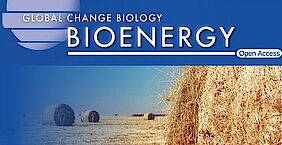Publications
EASAC's Environmental Experts call for international action to restrict climate-damaging forest bioenergy schemes
The international peer-reviewed journal "Global Change Biology - Bioenergy" has just published a paper authored by 15 of EASAC’s Environmental Experts on the serious mismatches between science and policy on forest bioenergy. This is based on the extensive work carried out within EASAC since 2015 related to the risks to climate of inappropriate forest bioenergy policies.
Forest biomass used for bioenergy – good or bad for the climate?
Biomass taken from forests was unconditionally classed as “renewable energy” under the EU Renewable Energy Directive (RED) in 2009. It has since been used in many member states to increase the proportion of their energy coming from “renewable” sources. It used to be taken for granted that using biomass is inherently good for the climate because the carbon in the biomass came from the atmosphere and can be reabsorbed as forests grow, so that biomass could be seen as ‘carbon neutral’. That concept may have had some validity in 2009 when the idea was that unused forestry residues would be the main source of bioenergy. However, the large renewable energy subsidies made available in some member states have led to a huge increase in forest biomass use - including the replacement of coal in large power stations. The process of harvesting forests to produce wood pellets has been industrialised to a scale of many millions of tonnes per year and transported over thousands of kilometres. Despite much scientific input warning that such practices could be damaging to both the climate and global forests, biomass continues to be classed as renewable under the RED revised in 2018. Moreover, emissions on biomass combustion are rated as zero in the EU’s Emissions Trading Scheme.
EASAC has repeatedly pointed out that the climate effects of current large-scale substitution of coal by forest biomass (especially when imported) may be increasing the risk of overshooting Paris agreement targets. The reason is simple - when the forest is harvested and used for bioenergy, all the carbon in the biomass enters the atmosphere in one pulse. Moreover, since emissions of CO2 per unit of electricity generated are higher (for reasons see the paper), the net effect is that the initial effect of the switch from coal is for emissions to INCREASE. That extra CO2 is only reabsorbed as forests regrow, so there is a time gap between releasing forest carbon and its reabsorption from the atmosphere - called the carbon payback period. Scientific studies show this period to be very dependent on the source of the biomass. It can be short where unused residues from sustainably-managed forests are involved, but as soon as additional trees start being cut to provide the raw material for pellet mills, the payback periods lengthen considerably, and extend to decades or even centuries depending on the specific case. Yet under the regulations, these important differences are ignored and all types of forest biomass are treated as ‘carbon neutral’ and the CO2 emitted when burnt counted as zero.
This basic mistake makes it possible to reduce national emissions on paper, because by simply switching from coal (where emissions have to be reported) to biomass (zero reporting) emissions can be reduced immediately. From a climate change perspective however, the reality is the opposite - the increase in emissions persists until the payback period is passed. With the urgency of action following the Paris Agreement to limit warming to 1.5oC, payback periods of more than a decade have become incompatible with climate change goals. EASAC has thus argued that present practices of large-scale pellet production, transport and use in power stations that cannot show short payback periods should no longer be seen as renewable energy - since they are increasing CO2 in our remaining window of opportunity to avoid overshooting Paris Agreement targets. As Professor Michael Norton (Environment Programme Director for EASAC) points out, “The large subsidies offered to switch from coal to forest biomass are achieving the opposite of that required for a true renewable energy, which should be to decrease atmospheric levels of CO2. This is bad for the climate and bad for public finances.”
This is not just a concern for the EU, because the current accounting rules under the UN Framework Convention on Climate Change (UNFCCC) allows imported biomass to be treated as zero emissions when burned (on the assumption that the exporting country has recorded the forest carbon loss in their land use reporting). This provides an accounting loophole which allows an importing country to zero-rate its bioenergy emissions - creating the impression that national emissions are reduced while in reality offloading the responsibility for reporting the net increase in emissions to the exporting country. Import of wood pellets is thus spreading to Asia. This international trend led 15 of EASAC’s Environment Steering Panel members to set out clearly the perversity of current policies to policymakers globally.
The paper in GCB Bioenergy explains in detail, drawing on both scientific and industry documents, why it is no longer reasonable to see the current large-scale substitution of coal by imported pellets as meeting the criteria for renewable energy. The paper offers a path to steering current unsustainable and counterproductive practices to improved reporting and governance which is more compatible with climate change objectives. Specifically, regulations must limit subsidies to biomass sources with short payback periods (examples include agricultural and forestry wastes, coppiced trees or fast-growing grasses). At the same time, the UNFCCC reporting guidelines should be urgently revised to remove current perverse incentives to exploit the loophole allowing imported biomass to be zero-emission. Reforms such as these would allow the industry to evolve to methods and scales which are more compatible with the basic purpose for which it has been supported - to achieve net reductions in GHG emissions in a climate-relevant timescale.
About the European Academies’ Science Advisory Council (EASAC)
EASAC is formed by the national science academies of the EU Member States, Norway and Switzerland, to collaborate in giving advice to European policy-makers. EASAC provides a means for the collective voice of European science to be heard. Through EASAC, the academies work together to provide independent, expert, evidence-based advice about the scientific aspects of European policies to those who make or influence policy within the European institutions. EASAC's thematic programmes (Environment, Energy and Biosciences) are guided by Steering Panels of scientists nominated by EASAC member academies. Further information can be found at www.easac.eu
Contact information
Professor Michael Norton, EASAC Environment Programme Director
Email: Michael.Norton@easac.eu. Tel int +33-553052718
--------------------------------------------------------------------------------------
Professor Lars Walloe, Chair of the EASAC Environment Steering Panel
Email: lars.walloe@medisin.uio.no. Tel int +47-90967531
Source document
Norton M.G., Jones M., Walloe L., Baldi A., Carli B. Cudlin P., Korhola A., Michalski R., Oszlanyi J., Novo F., Santos P.D. Schink B. Shepherd J.S., Vet L. and Wijkman A. (2019). Serious mismatches continue between science and policy on forest bioenergy. GCB Bioenergy https://doi.org/10.1111/gcbb.12643
Additional documents
Multi-functionality and Sustainability in the European Union's Forests
Forest Bioenergy and Carbon Neutrality
Forest bioenergy, carbon capture and storage, and carbon dioxide removal: an update
back to overview





























